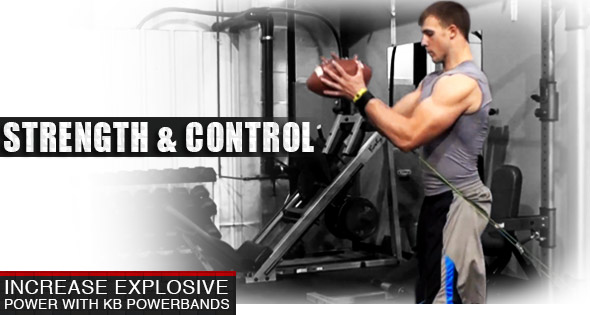Football Training: Receiver Drills
Every football player, regardless of position, should spend a percentage of training time focused on reflex development and ball handling skills. All football players need to throw with accuracy and catch with confidence. Wide receiver drills are essential those who are charged specifically with catching and running the ball, but all football players can benefit from arm strengthening and reflex sharpening receiver drills like the one demonstrated in the video below.
Catching a football securely and consistently requires development in three primary areas: Coordination, strength, and speed. Coordination begins in the link between mental and muscular action, and strength and speed in the arm muscles results from targeted strength training using the subtle action of resistance bands, not just weights. Strong arm muscles alone can support catching skills, but football players won’t achieve their full potential unless they also complete drills that support a fast snapping action and strengthen the link between the mind, the eye, and the fast moving muscles of the triceps and forearms (where the muscles that control the hands are located).
Receiver Hands Training
In the video above, the Kbands trainers demonstrate a simple exercise that can help football players build skill in all three of the areas most important to a wide receiver. Drills like these can make the catching motion feel more automatic and can help build muscle memory and coordination while strengthening and building endurance in the hands and arms.
These receiver drills require the use of a partner, a football, and the KB PowerBands with wrist straps. The move demonstrated here can be completed inside a gym or workout room, or outdoors as long as the bands can be attached to a sturdy anchor point.
Before starting this set of receiver drills, the football player places the straps around his wrists and attaches the desired level of resistance. The KB PowerBands come with four levels of resistance identified by different colored bands. The blue bands offer the tightest resistance and the yellow bands offer the most flexibility, so stronger receivers may decide to raise the level of difficulty while beginners may prefer to keep the resistance low.
Once the bands are strapped on and anchored to a point low to the ground, the football player stands at short distance from a partner who tosses him the ball. An overhand or underhand toss is fine, depending on the space available. The football player catches the ball by raising his arms against the resistance of the bands and then tosses it back without pausing.
The receiver should make sure that he stands close to the anchor point as he reaches up to catch the ball, since the resistance should pull the arms and shoulders down, not back. One of his feet should be placed slightly forward for balance, and as the ball is tossed, the football player should focus on driving his arms up to meet it, the way he would on the field.
Notice how, in the video, the football player tucks the ball every time he catches it. This trains the reflexes and builds muscle memory, so when he catches the ball on the field the tucking motion becomes automatic. But as he tucks the ball, he doesn’t pause long enough to give the arm muscles a rest. He simply completes the motion and then tosses the ball back quickly. A wide receiver drill like this one should be repeated about ten times in rapid succession. After ten reps, the football player can pause and let strength return to the arms before beginning the exercise again.
Wide Receiver Drills: Catching Drills and Resistance
It’s important to remember that while arm strength supports catching success, the catching motion is not based on strength alone. Form, repetition, confidence, and coordination are all essential parts of this equation. So football players should be careful not to load on the resistance and try to power through this receiver drill like a weight training exercise. The level of resistance should not be strong enough to alter or undermine the football player’s natural form. It should only be strong enough to help build the snapping reflex and increase the speed of the arms as they rise up to meet the ball.
After this set of wide receiver drills, the arms should not be exhausted or maxed out. But once the bands are removed, the catching motion should feel faster and more automatic. The difference will depend on the football player’s existing level of arm strength, and the resistance used for this receiver drill should be determined by individual football players and football coaches.
Wide Receiver Drills and Agility
The most effective wide receiver drills are those that help receivers develop their most valuable contributions to the game, mainly speed and agility. In order to maximize their potential, wide receivers need to exercise control, coordination, and the ability to move fast while throwing and catching with precision and confidence. These skills all depend on strength, but they also depend on practice, repetition and excellent technique. Resistance training can help. Adding a set of simple bands can apply biomechanical principles to increase tension and maximize results for both indoor gym workouts and running and passing exercises on the field.
For more information about exercises and training principles that can offer specific benefits to wide receivers, reach out to the experts at Kbands Training.com. Explore the website for guidance and tips that can help both football players and football coaches bring out the best in their games and their teams. The Kbands Training.com Athlete Performance Pack provides training tools and resources for football players as well as players and coaches for track, basketball, cheer and a wide range of other sports.
In the meantime, learn more about Kbands resistance training equipment like the KB PowerBands, the Kbands, and the KB Duo. Visit the site for deals, product details, and ordering information.

